Study on the Spatial and Temporal Evolution Patterns of Green Innovation Efficiency and Driving Factors in Three Major Urban Agglomerations in China—Based on the Perspective of Economic Geography
Abstract
:1. Introduction
1.1. Background
1.2. Literature Review
1.2.1. Research on the Connotation of Green Innovation
1.2.2. Research Related to Green Innovation Efficiency Measurement
1.2.3. Studies Related to Spatial Differences in Green Innovation Efficiency
1.2.4. Studies Related to the Influencing Factors of Green Innovation Efficiency
1.3. Purpose and Questions
2. Research and Design
2.1. Study Area
2.2. Research Methods
2.2.1. SBM-DEA Efficiency Measurement Model
2.2.2. Exploratory Spatial Data Analysis (ESDA)
2.2.3. Spatial Econometric Model
2.3. Index Selection
3. Result Analysis
3.1. Analysis of the Measurement Results of Green Innovation Efficiency
3.2. Spatial Disequilibrium Analysis of Green Innovation Efficiency
- (1)
- Kernel density estimation analysis
- (2)
- Analysis of the characteristics of spatio-temporal evolution
3.3. Exploratory Spatial Data Analysis (ESDA)
- (1)
- Global autocorrelation analysis
- (2)
- Local autocorrelation analysis
3.4. Spatial Regression Analysis of Influencing Factors
- (1)
- Selection of influencing factors
- (2)
- Result analysis
- (3)
- Robustness test
4. Discussion
4.1. Theoretical Value
4.2. Policy Enlightenment
5. Conclusions
Author Contributions
Funding
Institutional Review Board Statement
Informed Consent Statement
Data Availability Statement
Acknowledgments
Conflicts of Interest
References
- Dong, H.Z.; Li, X.; Zhang, R.J. Analysis on Spatio-temporal characteristics and driving factors of Guangdong-Hong Kong-Macau Greater Bay Area’s Green Innovation efficiency. Econ. Geogr. 2021, 41, 134–144. [Google Scholar]
- Rehman, S.U.; Kraus, S.; Shah, S.A. Analyzing the relationship between green innovation and environmental performance in large manufacturing firms. Technol. Forecast. Soc. Chang. 2021, 163, 120481. [Google Scholar] [CrossRef]
- Cui, Z.; Yang, F.; Ren, F.; Zhang, X.; Jing, Z. Assessing sustainability environmental performance of three urban agglomerations in China: An input–output modeling approach. Ecol. Indic. 2021, 130, 108079. [Google Scholar] [CrossRef]
- Guo, J.; Li, J. Efficiency evaluation and influencing factors of energy saving and emission reduction: An empirical study of China’s three major urban agglomerations from the perspective of environmental benefits. Ecol. Indic. 2021, 133, 108410. [Google Scholar] [CrossRef]
- Mi, W.; Zhao, K.; Zhang, P.; Li, M.S. Spatio-temporal evolution and driving mechanism of green innovation in China. Sustainability 2022, 14, 5121. [Google Scholar] [CrossRef]
- Ye, Q.; Zeng, G.; Dai, S.Q. Research on the effects of different policy tools on China’s emissions reduction innovation: Based on the panel data of 285 prefectural-level municipalities. China Popul. Resour. Environ. 2018, 28, 115–122. [Google Scholar]
- Brilhante, O.; Klaas, J. Green city concept and a method to measure green city performance over time applied to fifty cities globally: Influence of GDP, population size and energy efficiency. Sustainability 2018, 10, 2031. [Google Scholar] [CrossRef] [Green Version]
- Salehibarmi, M.; Rezaei, A.A.; Noori Kermani, A. The environmental performance evaluation of Tehran municipality based on the green city indicators. Urban Manag. Stud. 2018, 10, 1–15. [Google Scholar]
- Lv, Y.; Xie, Y.; Lou, X. Study on the Convergence of China’s Regional Green Innovation Efficiency. Sci. Technol. Prog. Policy 2019, 36, 37–42. [Google Scholar]
- Jiang, Z.; Lyu, P.; Ye, L.; Wenqian Zhou, Y. Green innovation transformation, economic sustainability and energy consumption during China’s new normal stage. J. Clean. Prod. 2020, 273, 123044. [Google Scholar] [CrossRef]
- Liu, P.; Zhang, L.; Tarbert, H. Analysis on Spatio-temporal Characteristics and Influencing Factors of Industrial Green Innovation Efficiency—From the Perspective of Innovation Value Chain. Preprints. Sustainability 2022, 14, 342. [Google Scholar] [CrossRef]
- Tian, Y.; Wang, R.; Liu, L.; Ren, Y. A spatial effect study on financial agglomeration promoting the green development of urban agglomerations. Sustain. Cities Soc. 2021, 70, 102900. [Google Scholar] [CrossRef]
- Paschek, F. Urban sustainability in theory and practice-circles of sustainability. Town Plan. Rev. 2015, 86, 745. [Google Scholar]
- Riffat, S.; Powell, R.; Aydin, D. Future cities and environmental sustainability. Future Cities Environ. 2016, 2, 1. [Google Scholar] [CrossRef]
- Tanguay, G.A.; Rajaonson, J.; Lefebvre, J.F.; Lanoie, P. Measuring the sustainability of cities: An analysis of the use of local indicators. Ecol. Indic. 2010, 10, 407–418. [Google Scholar] [CrossRef]
- Abbas, J.; Sağsan, M. Impact of knowledge management practices on green innovation and corporate sustainable development: A structural analysis. J. Clean. Prod. 2019, 229, 611–620. [Google Scholar] [CrossRef]
- Skordoulis, M.; Kyriakopoulos, G.; Ntanos, S.; Galatsidas, S.; Arabatzis, G.; Chalikias, M.; Kalantonis, P. The Mediating Role of Firm Strategy in the Relationship between Green Entrepreneurship, Green Innovation, and Competitive Advantage: The Case of Medium and Large-Sized Firms in Greece. Sustainability 2022, 14, 3286. [Google Scholar] [CrossRef]
- Skordoulis, M.; Ntanos, S.; Kyriakopoulos, G.L.; Arabatzis, G.; Galatsidas, S.; Chalikias, M. Environmental innovation, open innovation dynamics and competitive advantage of medium and large-sized firms. J. Open Innov. Technol. Mark. Complex. 2020, 6, 195. [Google Scholar] [CrossRef]
- Liu, T.; Li, Z.; Zhang, C.; Xia, Q. How comprehensive innovation reform pilot improve urban green innovation efficiency?—Evidence from China. Sustainability 2022, 14, 4550. [Google Scholar] [CrossRef]
- Seman, N.A.A.; Govindan, K.; Mardani, A. The mediating effect of green innovation on the relationship between green supply chain management and environmental performance. J. Clean. Prod. 2019, 229, 115–127. [Google Scholar] [CrossRef]
- Xu, L.; Fan, M.; Yang, L.; Shao, S. Heterogeneous green innovations and carbon emission performance: Evidence at China’s city level. Energy Econ. 2021, 99, 105269. [Google Scholar] [CrossRef]
- Wang, X.; Li, J.; Song, R.; Li, J. 350 cities of China exhibited varying degrees of carbon decoupling and green innovation synergy. Energy Rep. 2022, 8, 312–323. [Google Scholar] [CrossRef]
- Wang, S.; Lin, W.; Zhang, Z.; Wang, H.; Liu, X.; Liu, B. Does the environment information announcement promote green innovation? A quasi-natural experimental evidence from the city-level of China. Ecol. Indic. 2022, 136, 108720. [Google Scholar] [CrossRef]
- Mbanyele, W.; Wang, F. Environmental regulation and technological innovation: Evidence from China. Environ. Sci. Pollut. Res. 2022, 29, 12890–12910. [Google Scholar] [CrossRef]
- Trevlopoulos, N.S.; Tsalis, T.A.; Evangelinos, K.I. The influence of environmental regulations on business innovation, intellectual capital, environmental and economic performance. Environ. Syst. Decis. 2021, 41, 163–178. [Google Scholar] [CrossRef]
- Wu, F.; Fu, X.; Zhang, T.; Wu, D.; Sindakis, S. Examining whether government environmental regulation promotes green innovation efficiency—Evidence from China’s Yangtze river economic belt. Sustainability 2022, 14, 1827. [Google Scholar] [CrossRef]
- Bz, A.; Lan, Y.A.; Csb, C. How does urban environmental legislation guide the green transition of enterprises? Based on the perspective of enterprises’ green total factor productivity. Energy Econ. 2022, 110, 106032. [Google Scholar]
- Shahzad, M.; Qu, Y.; Javed, S.A. Relation of environment sustainability to CSR and green innovation: A case of Pakistani manufacturing industry. J. Clean. Prod. 2020, 253, 119938. [Google Scholar] [CrossRef]
- Brunnermeier, S.B.; Cohen, M.A. Determinants of environmental innovation in US manufacturing industries. J. Environ. Econ. Manag. 2003, 45, 278–293. [Google Scholar] [CrossRef]
- Feng, Y.C. Effects of environmental regulation and FDI on urban innovation in China: A spatial Durbin econometric analysis. J. Clean. Prod. 2019, 235, 210–224. [Google Scholar] [CrossRef]
- Zhao, T.; Zhou, H.; Jiang, J.; Yan, W. Impact of green finance and environmental regulations on the green innovation efficiency in China. Sustainability 2022, 14, 3206. [Google Scholar] [CrossRef]
- Huang, Y.; Chen, C.; Lei, L.; Zhang, Y. Impacts of green finance on green innovation: A spatial and nonlinear perspective. J. Clean. Prod. 2022, 137, 132548. [Google Scholar] [CrossRef]
- Liao, B.; Li, L. Spatial division of labor, specialization of green technology innovation process and urban coordinated green development: Evidence from China. Sustain. Cities Soc. 2022, 80, 103778. [Google Scholar] [CrossRef]
- Huang, W.H.; Wang, M.D. The measurement of green technology innovation efficiency in the manufacturing industry in the Yangtze River Economic Belt. Stat. Decis. 2021, 37, 61–63. [Google Scholar]
- Wang, X.; Wang, S.; Zhang, Y.; Li, M.S. The Impact of Environmental Regulation and Carbon Emissions on Green Technology Innovation from the Perspective of Spatial Interaction: Empirical Evidence from Urban Agglomeration in China. Sustainability 2022, 14, 5381. [Google Scholar] [CrossRef]
- Liu, Y.; Liu, S.; Shao, X.; He, Y. Policy spillover effect and action mechanism for environmental rights trading on green innovation: Evidence from China’s carbon emissions trading policy. Renew. Sustain. Energy Rev. 2022, 153, 111779. [Google Scholar] [CrossRef]
- Wang, K.; Bian, Y.; Cheng, Y.; Li, M.S. Exploring the spatial correlation network structure of green innovation efficiency in the Yangtze river delta, China. Sustainability 2022, 14, 3903. [Google Scholar] [CrossRef]
- Fan, J.D.; Xiao, Z.H. Analysis of Spatial Correlation Network of China’s Green Innovation. J. Clean. Prod. 2021, 299, 126815. [Google Scholar] [CrossRef]
- Zhang, R.; Tai, H.; Cheng, K.-T.; Cao, Z.; Dong, H.; Hou, J. Analysis on evolution characteristics and dynamic mechanism of urban green innovation network: A case study of Yangtze river economic belt. Sustainability 2021, 14, 297. [Google Scholar] [CrossRef]
- Gao, D.; Li, G.; Yu, J. Does digitization improve green total factor energy efficiency? Evidence from Chinese 213 cities. Energy 2022, 247, 123395. [Google Scholar] [CrossRef]
- Gao, G.K.; Wang, Y.Q. Green Innovation Efficiency and Its Influencing Factors of Energy-intensive Industry in Beijing-TianjinHebei Metropolitan region—Empirical research Based on Spatial Perspective. J. Ind. Technol. Econ. 2018, 37, 137–144. [Google Scholar]
- Ren, Y.; Niu, C.; Niu, T.; Yao, X. Theoretical model and empirical study of green innovation efficiency. J. Manag. World 2014, 7, 166–178. [Google Scholar]
- Blättel-Mink, B. Innovation towards sustainable economy-the integration of economy and ecology in companies. Sustain. Dev. 1998, 6, 49–58. [Google Scholar] [CrossRef]
- Amore, M.D.; Bennedsen, M. Corporate governance and green innovation. J. Environ. Econ. Manag. 2016, 75, 54–72. [Google Scholar] [CrossRef]
- Mbanyele, W.; Huang, H.; Li, Y.; Muchenje, L.T.; Wang, F. Corporate social responsibility and green innovation: Evidence from mandatory CSR disclosure laws. Econ. Lett. 2022, 212, 110322. [Google Scholar] [CrossRef]
- El-Kassar, A.N.; Singh, S.K. Green innovation and organizational performance: The influence of big data and the moderating role of management commitment and HR practices. Technol. Forecast. Soc. Chang. 2019, 144, 483–498. [Google Scholar] [CrossRef]
- Wang, J.; Du, G.J. Spatial difference and distribution dynamics of urban green innovation level in China. Chin. J. Popul. Sci. 2021, 9, 74–85. [Google Scholar]
- Ma, L.; Hong, Y.; Chen, X.; Quan, X. Can green innovation and new urbanization be synergistic development? empirical evidence from Yangtze river delta city group in China. Sustainability 2022, 14, 5765. [Google Scholar] [CrossRef]
- Li, B.; Peng, X.; Chen, Z.H. Environmental Regulation, FDI and China’s Pollution Control Technology Innovation: Based on the Analysis of Inter-provincial Dynamic Panel Data. J. Financ. Econ. 2011, 37, 92–102. [Google Scholar]
- Xiao, L.M.; Gao, J.F.; Han, B. Spatial spillover effects of China’s inter-provincial green innovation efficiency: A test of homogeneity and heterogeneity. J. Ind. Technol. Econ. 2018, 37, 30–38. [Google Scholar]
- Yang, J. The measurement of green innovation efficiency of cities in the Yangtze River Delta and analysis of influencing factors. Econ. Res. Guide 2020, 25, 63–65. [Google Scholar]
- Li, X.S.; Zeng, Y.H. Measurement of China’s regional innovative green development efficiency and its influencing factors. Sci. Technol. Prog. Policy 2020, 37, 33–42. [Google Scholar]
- Peng, Y.; Fan, Y.; Liang, Y. A green technological innovation efficiency evaluation of technology-based smes based on the undesirable sbm and the malmquist index: A case of Hebei province in China. Sustainability 2021, 13, 11079. [Google Scholar] [CrossRef]
- Li, L.; Xia, X.H. Research on the efficiency and influencing factors of green innovation in pollution-intensive industries. Res. Soc. Chin. Charact. 2018, 1, 83–88. [Google Scholar]
- Liu, M.G. Research on the spatial distribution and convergence of green innovation efficiency of regional innovation systems. J. Ind. Technol. Econ. 2017, 36, 10–18. [Google Scholar]
- Wang, K.L.; Zhang, F.Q. Investigating the spatial heterogeneity and correlation network of green innovation efficiency in China. Sustainability 2021, 13, 1104. [Google Scholar] [CrossRef]
- Qian, L.; Xiao, R.Q.; Chen, Z.W. Research on Green Technology Innovation efficiency and Regional differences of Industrial Enterprises in China—Based on Common Frontier Theory and DEA Model. Econ. Theory Bus. Manag. 2015, 1, 26–43. [Google Scholar]
- Peng, J.C.; Xu, R.R.; Fu, L.N.; Yi, M.; Xu, Y.D. The evolution law of green innovation efficiency of industrial enterprises in the Yangtze River Economic Belt. China Environ. Sci. 2019, 39, 4886–4900. [Google Scholar]
- Kuang, C.; Wen, Z.Z.; Peng, W.B. The threshold effect of shadow economy on green innovation efficiency. Econ. Geogr. 2019, 39, 184–193. [Google Scholar]
- Li, W.H.; Cao, W.L. FDI, environmental regulation and regional green innovation efficiency. Stat. Decis. 2020, 36, 118–122. [Google Scholar]
- Fan, F.; Lian, H.; Liu, X.; Wang, X. Can environmental regulation promote urban green innovation Efficiency? An empirical study based on Chinese cities. J. Clean. Prod. 2020, 287, 125060. [Google Scholar] [CrossRef]
- Zhang, J.; Kang, L.; Li, H.; Ballesteros-Pérez, P.; Skitmore, M.; Zuo, J. The Impact of Environmental Regulations on Urban Green Innovation Efficiency: The Case of Xi’an. Sustain. Cities Soc. 2020, 57, 102123. [Google Scholar] [CrossRef]
- Ji, X.H.; Wei, C. The impact of FDI and environmental regulations on technological innovation: Based on the analysis of China’s inter-provincial panel data. Sci. Technol. Manag. Res. 2017, 37, 35–41. [Google Scholar]
- Liu, B.; Sun, Z.; Li, H. Can carbon trading policies promote regional green innovation efficiency? Empirical data from pilot regions in China. Sustainability 2021, 13, 2891. [Google Scholar] [CrossRef]
- Du, K.; Cheng, Y.; Yao, X. Environmental regulation, green technology innovation, and industrial structure upgrading: The road to the green transformation of Chinese cities. Energy Econ. 2021, 98, 105247. [Google Scholar] [CrossRef]
- Ccl, A.; Cclb, C. How does green finance affect green total factor productivity? Evidence from China. Energy Econ. 2022, 107, 105863. [Google Scholar]
- Zhu, Y.; Zhou, X.; Li, J.; Wang, F.; Li, M.S. Technological innovation, fiscal decentralization, green development efficiency: Based on spatial effect and moderating effect. Sustainability 2022, 14, 4316. [Google Scholar] [CrossRef]
- Yang, J.; Wang, S.; Sun, S.; Zhu, J. Influence mechanism of high-tech industrial agglomeration on green innovation performance: Evidence from China. Sustainability 2022, 14, 3187. [Google Scholar] [CrossRef]
- Lca, B.; Kwc, D. The spatial spillover effect of low-carbon city pilot scheme on green efficiency in China’s cities: Evidence from a quasi-natural experiment. Energy Economics. 2022, 110, 106018. [Google Scholar]
- Sun, H.; Edziah, B.K.; Sun, C. Institutional quality, green innovation and energy efficiency. Energy Policy 2019, 135, 111002. [Google Scholar] [CrossRef]
- Li, R.; Ramanathan, R. Exploring the relationships between different types of environmental regulations and environmental performance: Evidence from China. J. Clean. Prod. 2018, 196, 1329–1340. [Google Scholar] [CrossRef]
- Jia, P.R.; Li, K.; Shao, S. Choice of technological change for China’s low-carbon development: Evidence from three urban agglomerations. J. Environ. Manage. 2018, 206, 1308–1319. [Google Scholar] [CrossRef] [PubMed]
- Miao, C.L.; Duan, M.M.; Zuo, Y.; Wu, X.Y. Spatial heterogeneity and evolution trend of regional green innovation efficiency--an empirical study based on panel data of industrial enterprises in China’s provinces. Energy Policy 2021, 156, 112370. [Google Scholar] [CrossRef]
- Hu, A.; Jefferson, G.H.; Qian, J. R&D and technology transfer: Firm-level evidence from Chinese industry. Rev. Econ. Stat. 2005, 87, 780–786. [Google Scholar]
- Wang, L.; Ye, W.; Chen, L. Research on Green Innovation of the Great Changsha-Zhuzhou-Xiangtan City Group Based on Network. Land 2021, 10, 1198. [Google Scholar] [CrossRef]
- Corradini, C. Location determinants of green technological entry: Evidence from European regions. Small Bus. Econ. 2017, 52, 845–858. [Google Scholar] [CrossRef] [Green Version]
- Kijek, T.; Matras-Bolibok, A. Spatial Distribution of Eco-Innovation Performance: Evidence from European Countries. Eur. Res. Stud. J. 2020, XXIII, 766–778. [Google Scholar] [CrossRef]
- Saunila, M.; Ukko, J.; Rantala, T. Sustainability as a driver of green innovation investment and exploitation. J. Clean. Prod. 2018, 179, 631–641. [Google Scholar] [CrossRef]
- Han, M.S.; Chen, W. Determinants of eco-innovation adoption of small and medium enterprises: An empirical analysis in Myanmar. Technol. Forecast. Soc. Chang. 2021, 173, 121146. [Google Scholar] [CrossRef]
- Cuerva, M.C.; Triguero-Cano, Á.; Córcoles, D. Drivers of green and non-green innovation: Empirical evidence in Low-Tech SMEs. J. Clean. Prod. 2014, 68, 104–113. [Google Scholar] [CrossRef]
- Zailani, S.; Govindan, K.; Iranmanesh, M.; Shaharudin, M.R.; Chong, Y.S. Green innovation adoption in automotive supply chain: The Malaysian case. J. Clean. Prod. 2015, 108, 1115–1122. [Google Scholar] [CrossRef]
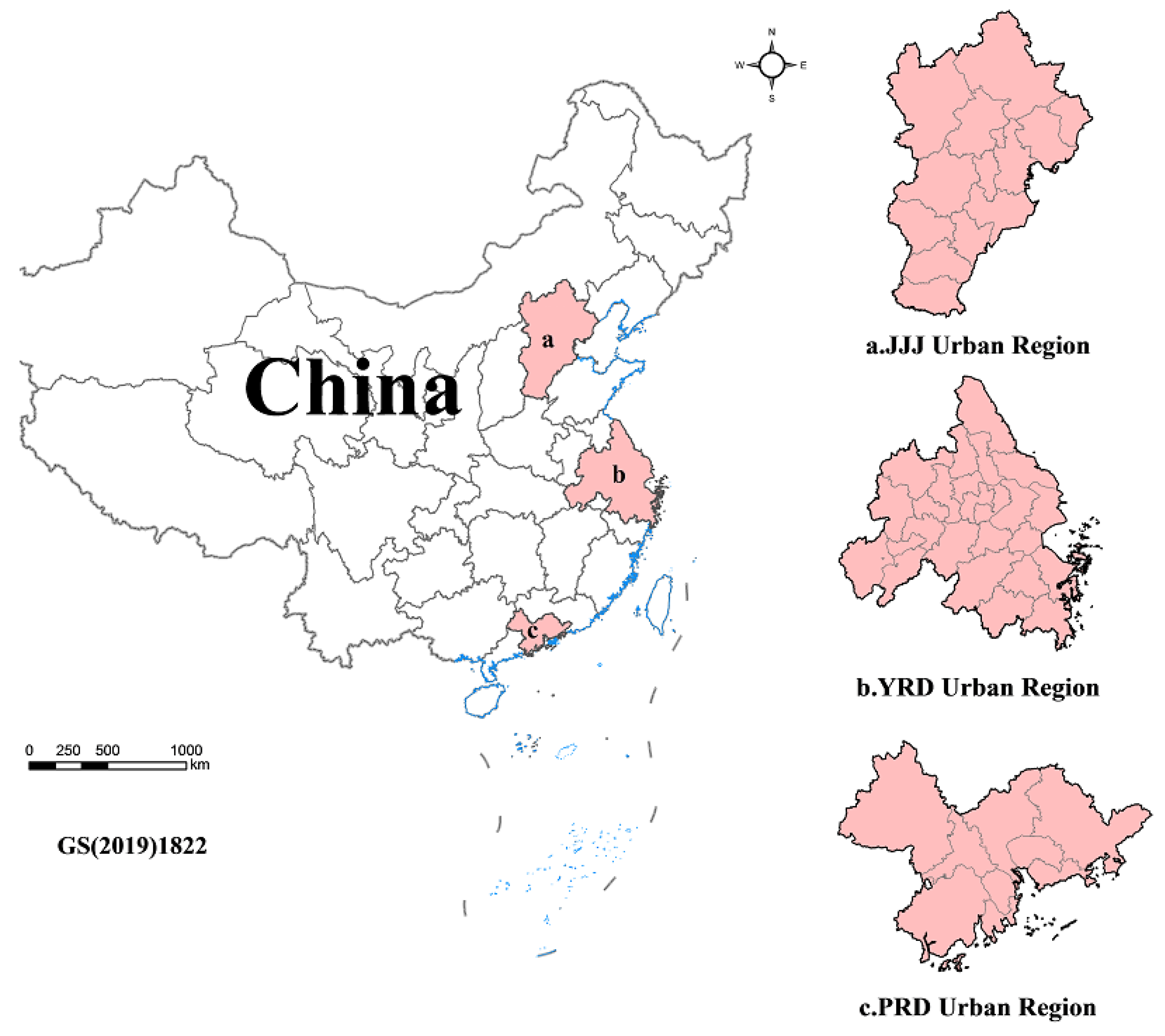
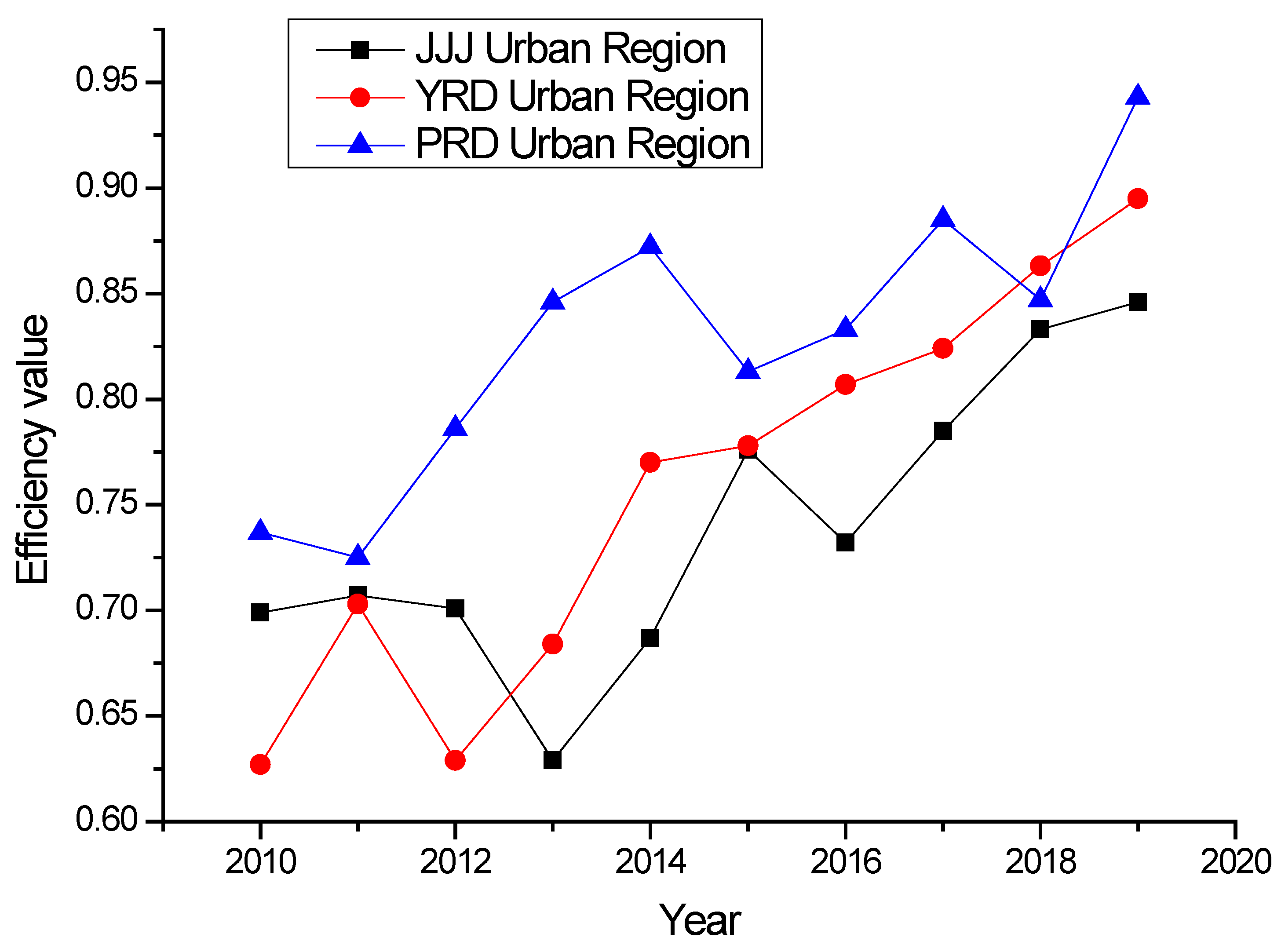
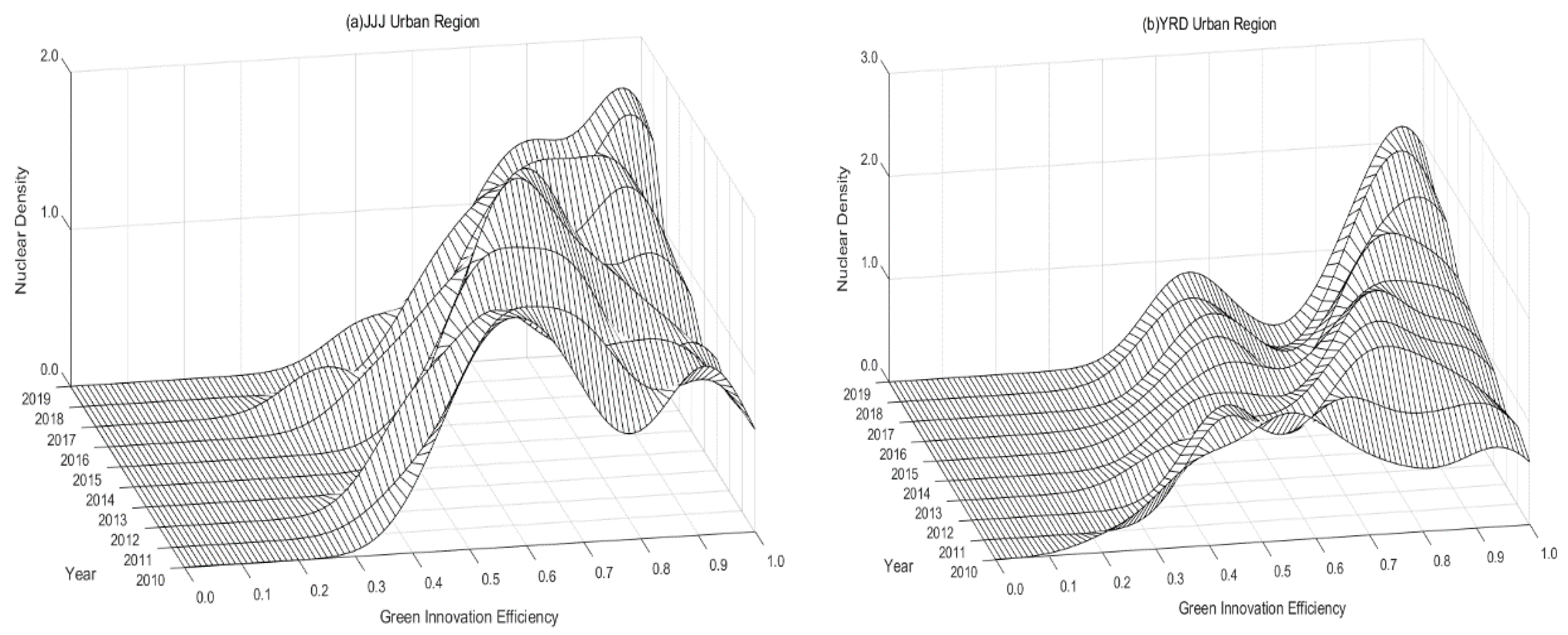

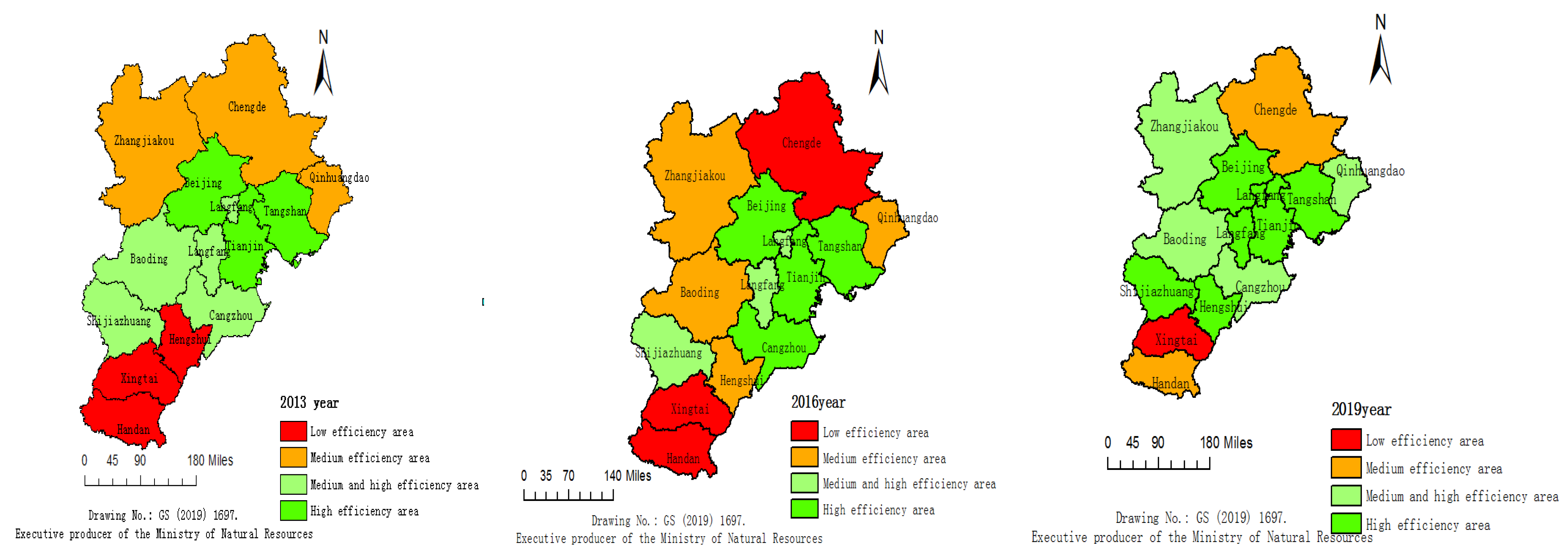

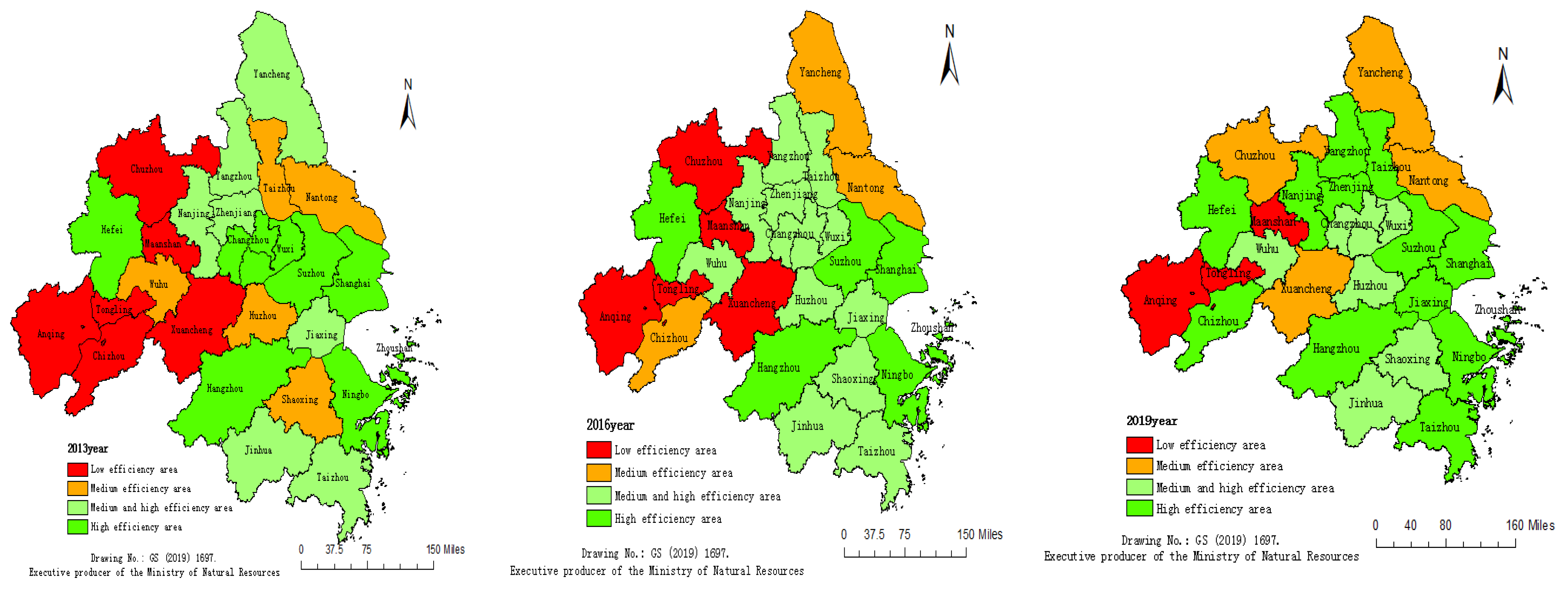
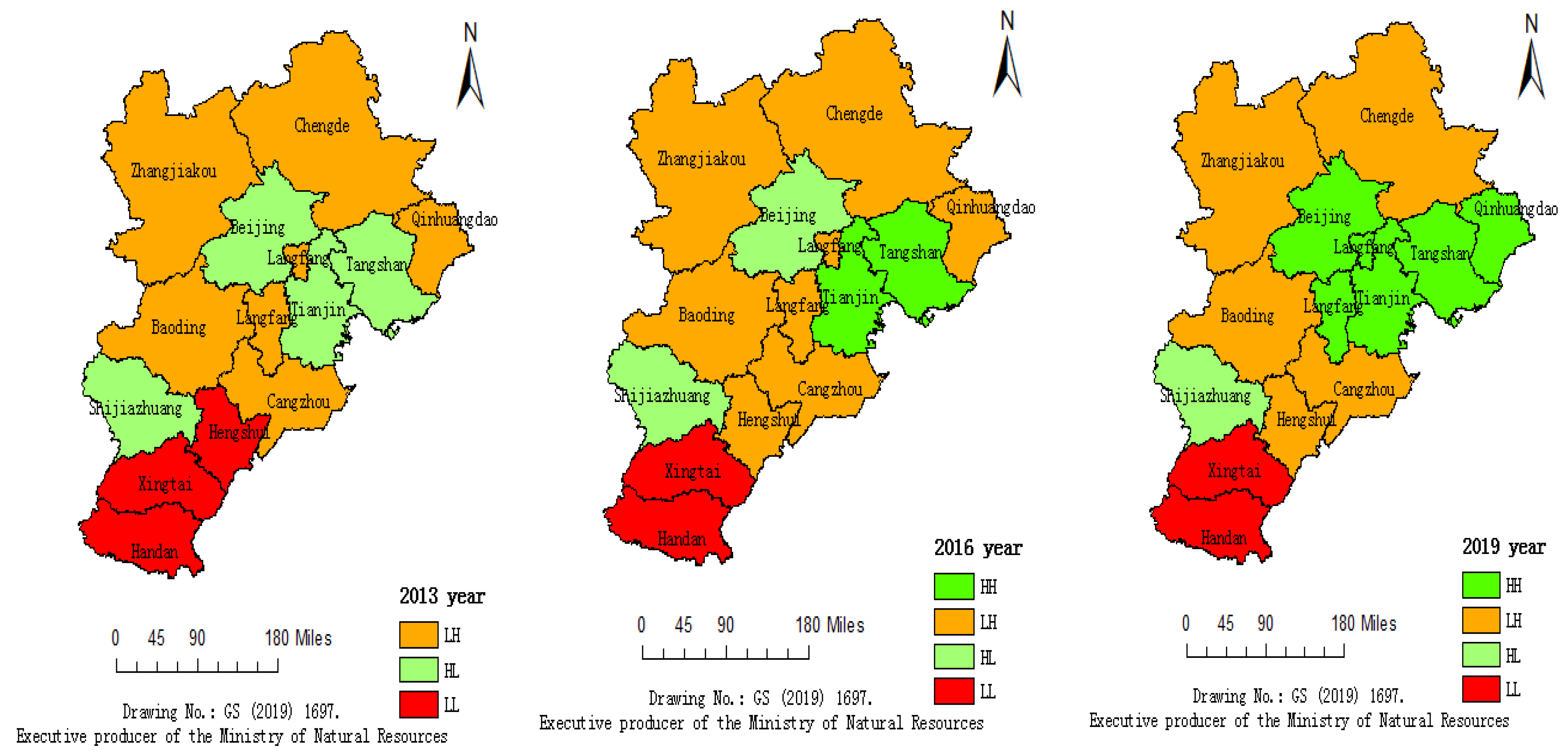

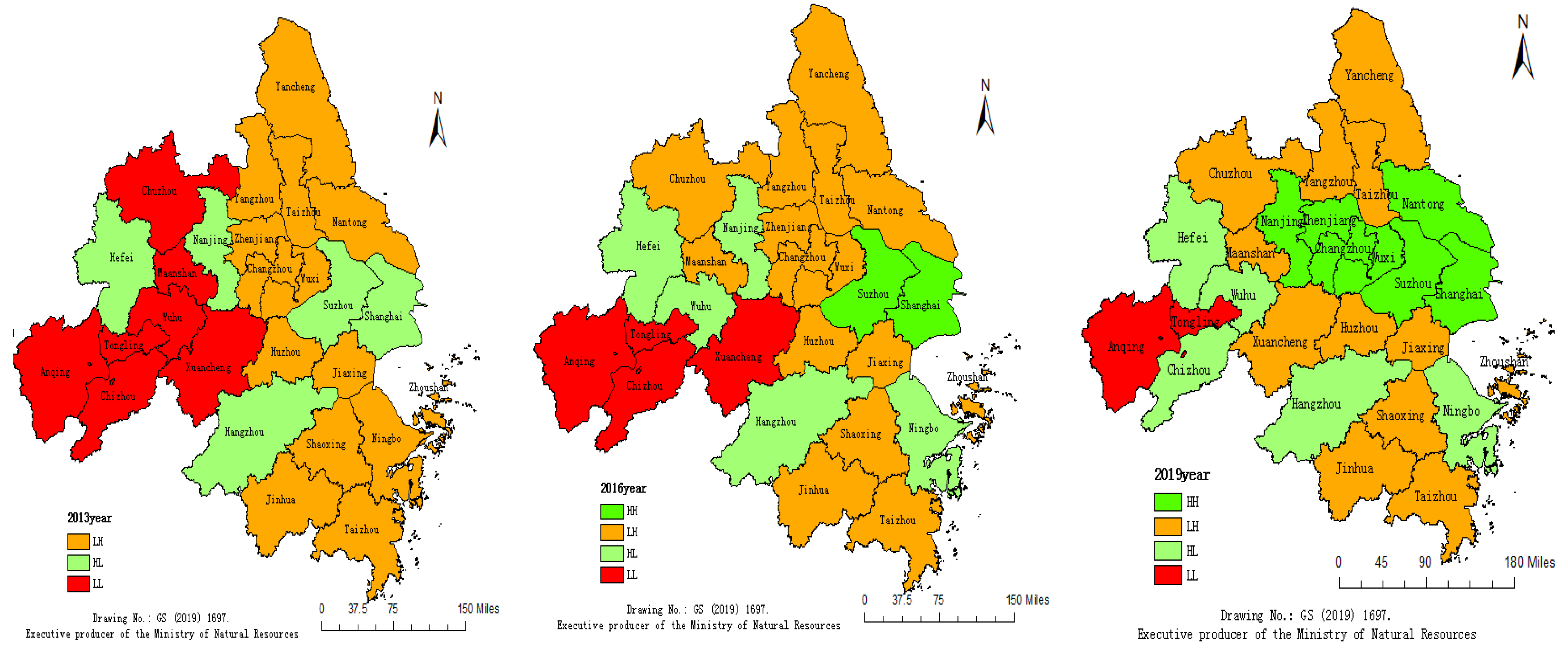
| Indicator Type | Indicator Composition | Indicator Representation | Unit |
|---|---|---|---|
| Input index | Manpower input | R&D practitioner full-time equivalent | people/year |
| Capital investment | R&D capital stock | million yuan | |
| Energy input | Electricity consumption of the whole society | million KW.h | |
| Total water supply | ten thousand tons | ||
| Output index | Economic output | New product sales revenue | million yuan |
| Technical output | Number of green invention patent applications granted | million | |
| Ecological output | Greening coverage of built-up areas | % | |
| Non-expected output | Year-on-year ratio of commercial banks’ non-performing loan amounts | % | |
| Industrial wastewater discharge | million tons | ||
| Industrial waste gas emissions | million standard cubic meters |
| Year | JJJ Urban Region | PRD Urban Region | YRD Urban Region | Three Major Urban Regions | ||||
|---|---|---|---|---|---|---|---|---|
| Moran’s I | Z | Moran’s I | Z | Moran’s I | Z | Moran’s I | Z | |
| 2010 | 0.025 *** | 2.457 | −0.043 *** | 3.646 | 0.032 *** | 2.875 | 0.016 *** | 1.978 |
| 2011 | 0.026 *** | 2.561 | 0.049 *** | 4.138 | 0.023 *** | 2.328 | 0.024 *** | 2.347 |
| 2012 | 0.017 ** | 1.987 | 0.058 ** | 4.497 | 0.035 * | 3.237 | 0.037 ** | 3.517 |
| 2013 | 0.043 *** | 3.665 | 0.051 *** | 4.208 | 0.046 *** | 3.809 | 0.028 *** | 2.659 |
| 2014 | 0.068 *** | 5.337 | −0.055 *** | 4.388 | 0.053 ** | 4.334 | 0.038 *** | 3.434 |
| 2015 | 0.042 *** | 3.599 | 0.057 *** | 4.443 | 0.056 *** | 4.417 | 0.036 *** | 3.217 |
| 2016 | 0.013 ** | 1.871 | 0.062 *** | 4.659 | 0.058 * | 4.497 | 0.015 ** | 1.968 |
| 2017 | 0.018 * | 2.137 | 0.063 *** | 4.724 | 0.061 ** | 4.582 | 0.023 ** | 2.332 |
| 2018 | 0.034 *** | 3.051 | 0.071 *** | 5.345 | 0.077 ** | 5.836 | 0.036 *** | 3.337 |
| 2019 | 0.048 *** | 3.987 | −0.076 *** | 5.743 | 0.082 *** | 6.019 | 0.029 *** | 2.783 |
| Influence Level | Influencing Factors | Variable Abbreviation | Measurement Index | Unit |
|---|---|---|---|---|
| Economic development level | Per capita income level | PGDP | Per capita GDP | Person/yuan |
| Industrial structure | INDU | Output value of secondary industry/GDP | % | |
| SERV | Output value of tertiary industry/GDP | % | ||
| Operation environment of science and technology | Financial development level | FINA | Balance of deposits and loans of financial institutions | Yuan |
| The level of opening up | FDI | Foreign direct investment/GDP | % | |
| Urban informatization level | INTERNET | Total output value of Post and Telecommunications Services/GDP | % | |
| Government system orientation | Intensity of environmental regulation | ER | Industrial pollution Control Expenditure/GDP | % |
| Higher education level | STU | Number of college students | Person |
| Inspection | Statistical Value | p-Value | Inspection | Statistical Value | p-Value |
|---|---|---|---|---|---|
| LM (LAG) | 52.247 *** | 0.000 | LM (ERR) | 46.734 *** | 0.000 |
| R-LM (LAG) | 37.264 | 0.073 | R-LM (ERR) | 12.718 *** | 0.000 |
| Spatial effect-LR | 564.257 *** | 0.000 | Time effect-LR | 105.673 *** | 0.000 |
| Wald spatial lag | 15.208 *** | 0.000 | Wald spatial error | 15.109 *** | 0.000 |
| LR spatial lag | 14.994 *** | 0.001 | LR spatial lag | 14.930 *** | 0.001 |
| Explanatory Variable | Three Major Urban Agglomerations | JJJ Urban Region | YRD Urban Region | PRD Urban Region |
|---|---|---|---|---|
| InINDU | −0.006 *** (0.049) | −0.010 *** (0.052) | −0.004 ** (0.037) | −0.009 ** (0.029) |
| InSERV | 0.004 ** (0.002) | 0.003 * (0.002) | 0.001 ** (0.001) | 0.007 *** (0.002) |
| InER | 0.002 *** (0.000) | 0.004 *** (0.001) | 0.003 ** (0.002) | 0.001 ** (0.001) |
| InINTERNET | −0.001 (0.002) | −0.013 * (0.014) | 0.007 (0.002) | 0.039 (0.021) |
| InPGDP | 0.421 *** (0.039) | 0.394 *** (0.042) | 0.546 *** (0.027) | 0.684 *** (0.043) |
| InFDI | 0.018 ** (0.009) | 0.016 *** (0.004) | −0.013 ** (0.007) | −0.014 ** (0.007) |
| InSTU | 0.126 *** (0.003) | 0.075 *** (0.000) | 0.137 *** (0.007) | 0.219 *** (0.002) |
| InFINA | 0.454 (0.036) | −0.433 (0.054) | 0.275 (0.087) | 0.886 (0.029) |
| 0.452 *** (0.003) | −0.242 ** (0.015) | 0.368 *** (0.007) | 0.417 *** (0.000) | |
| Sigma_2e | 0.038 *** (0.002) | 0.052 *** (0.004) | 0.032 *** (0.002) | 0.040 *** (0.003) |
| R2 | 0.32 | 0.27 | 0.24 | 0.35 |
| Explanatory Variable | Geographical Distance | Economic Distance | Economic Geography Nesting |
|---|---|---|---|
| InINDU | −0.003 *** (0.009) | −0.001 *** (0.082) | −0.004 ** (0.137) |
| InSERV | 0.002 ** (0.000) | 0.000 * (0.023) | 0.001 ** (0.017) |
| InER | 0.001 *** (0.000) | 0.001 *** (0.001) | 0.001 ** (0.032) |
| InINTERNET | −0.001 (0.012) | −0.000 (0.014) | 0.002 (0.002) |
| InPGDP | 0.362 *** (0.000) | 0.394 *** (0.002) | 0.286 *** (0.007) |
| InFDI | 0.013 ** (0.019) | 0.009 *** (0.000) | −0.013 ** (0.027) |
| InSTU | 0.098 *** (0.000) | 0.075 *** (0.000) | 0.037 *** (0.000) |
| InFINA | 0.329 (0.016) | −0.332 (0.053) | 0.278 (0.074) |
| 0.376 *** (0.000) | −0.442 ** (0.005) | 0.428 *** (0.017) | |
| Sigma_2e | 0.023 *** (0.014) | 0.035 *** (0.007) | 0.032 *** (0.000) |
| R2 | 0.29 | 0.27 | 0.24 |
Publisher’s Note: MDPI stays neutral with regard to jurisdictional claims in published maps and institutional affiliations. |
© 2022 by the authors. Licensee MDPI, Basel, Switzerland. This article is an open access article distributed under the terms and conditions of the Creative Commons Attribution (CC BY) license (https://creativecommons.org/licenses/by/4.0/).
Share and Cite
Hu, B.; Yuan, K.; Niu, T.; Zhang, L.; Guan, Y. Study on the Spatial and Temporal Evolution Patterns of Green Innovation Efficiency and Driving Factors in Three Major Urban Agglomerations in China—Based on the Perspective of Economic Geography. Sustainability 2022, 14, 9239. https://doi.org/10.3390/su14159239
Hu B, Yuan K, Niu T, Zhang L, Guan Y. Study on the Spatial and Temporal Evolution Patterns of Green Innovation Efficiency and Driving Factors in Three Major Urban Agglomerations in China—Based on the Perspective of Economic Geography. Sustainability. 2022; 14(15):9239. https://doi.org/10.3390/su14159239
Chicago/Turabian StyleHu, Biao, Kai Yuan, Tingyun Niu, Liang Zhang, and Yuqiong Guan. 2022. "Study on the Spatial and Temporal Evolution Patterns of Green Innovation Efficiency and Driving Factors in Three Major Urban Agglomerations in China—Based on the Perspective of Economic Geography" Sustainability 14, no. 15: 9239. https://doi.org/10.3390/su14159239
APA StyleHu, B., Yuan, K., Niu, T., Zhang, L., & Guan, Y. (2022). Study on the Spatial and Temporal Evolution Patterns of Green Innovation Efficiency and Driving Factors in Three Major Urban Agglomerations in China—Based on the Perspective of Economic Geography. Sustainability, 14(15), 9239. https://doi.org/10.3390/su14159239






